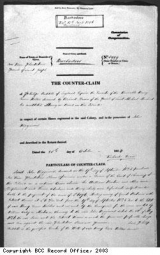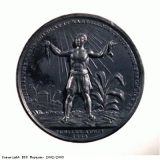The politics of emancipation
Feelings ran high in the city of Bristol over the question of slavery, especially during the violent election campaign of 1830 and the Bristol Riots of 1831. The election campaign of 1830 had two rival candidates both from the ‘Whig’ party (which could be described as today’s Liberal Democratic Party). One was against the emancipation (ultimate freedom) of slaves, and one was for emancipation. Edward Protheroe, whose family traded with the Caribbean, was on the side of emancipation. James Evan Baillie, also from a family who traded with the Caribbean, was against. The two fought a bitter election campaign. Baillie won the Whig party vote by about 500 votes, and was elected as the Whig party’s Member of Parliament for Bristol. Although Edward Protheroe had lost the 1830 election, his supporters gave money to present him with a silver vase. It was in recognition of his work for the emancipation (freedom) of slaves. The design includes a child slave kneeling before Britannia, the mythical female figure who represents Britain.
Richard Hart Davis was the Tory (Conservative) Member of Parliament for Bristol from 1812 until 1831. He withdrew as a candidate in the 1831 election, which saw the eruption of the Bristol Riots. The riots were over the proposed Reform Bill, which was a proposed new law to widen the range of people who could vote. Before this the number of people who had the vote was very small (about 11,000 in Bristol). Davis was against this increase of those who could vote, but the public mood was in favour of it, and it was obvious that he would get very few votes. The Reform Bill (the proposed law to change the voting system) became law in 1832. Parliamentary constituencies were reorganised so that new towns got an MP for the first time. Any man who owned or occupied a house valued at £10 per year was given the vote. This extended the vote to many more people than before. Citizens of Bristol celebrated with a party on Brandon Hill. The new voters elected new MPs who had little or no financial involvement and connection with slavery and its associated industries (such as sugar and tobacco). Their interests often lay elsewhere, in social reform for example. It was these new Members of Parliament who voted for the abolition of slavery in 1833.
The Bristol riots of 1831 were part of the general unrest in Britain in the 1820s before the Reform Act of 1832 (a new law passed by the Houses of Parliament to widen the number of people who had the vote). The Caribbean island of Jamaica in 1831 also experienced upheaval in the form of the Baptist Wars, a rebellion by slaves against slavery. Rumours that slaves were to be given their freedom caused unrest amongst the slaves in Jamaica. This unrest finally erupted in full-scale rebellion. Plantation owners accused the Baptist Church preachers in the island of encouraging the slaves’ hopes of freedom and causing the rebellion. In Bristol, the 1831 riots created strange scenes. The pro-slavery Captain Christopher Claxton, who was involved in local politics, had rioters in his house in Queen’s Square. Claxton’s black servant threw one of the rioters out of a window of the house. The square was partially destroyed as a result of the riot. This painting is of the burning of the Bishop’s Palace in Bristol, during the riot.
The Emancipation Act was finally passed by Parliament in 1833, after the two sides came to an agreement on the issue of compensation. The slave owners and their supporters accepted the loss of their ‘property’ (slaves) in return for compensation (money) from the government. £20 million was paid to slave owners by the British government, as compensation for this ‘loss’. Slave owners in Bristol received over £500,000 (worth about £25 million today), a vast sum at that time. The Baillie family from Bristol, who owned plantations in the Caribbean, were paid £110,000 for their 3,100 slaves (about £5,500,000 today). The Daniels, a prominent Bristol family who traded in sugar, received £102,000 (about £5,100,000 today). The Pinney family, plantation owners and sugar traders in Bristol, received compensation of about £36,000 (about £1,800,000 today). This 1834 counter-claim (a claim against a debt) was for a share of the compensation for the Ives River Plantation. John Hugginson had bought the Ives River Plantation on the Caribbean island of Barbados in 1825. The descendants of the Hon. Henry Evans claimed an interest in the estate, probably for money lent to Hugginson by Evans. Their claim was for the compensation money due for 193 field slaves, 13 domestic slaves, 46 children and 5 aged or sick slaves, ‘worth’ £14,690 (at least £750,000 in today’s money).
Commemorative medallions, or souvenirs, like this one, were issued to mark the abolition of slavery in 1834. Around the figure of a slave breaking his chains are the words from the Bible, Psalm 118: ‘This is the work of the Lord, it is marvellous in our eyes’. The Emancipation Act of 1833 freed the slaves on 1 August 1834. But, they were not given their full freedom straight away. It was felt that the slaves were not used to being independent. It was thought that they needed to be trained to be able to live as free people. Because of this, the end of slavery did not really mean freedom for the slaves. A system called Apprenticeship was set up. Former slaves had to work for low wages for their old masters. Many saw this system as another form of slavery. True freedom came in 1838, when the apprenticeship system was abolished. But many of the freed slaves had no option but to continue working for their old masters for low wages. There was no where else they could go and work.
Much of the money that the owners received from compensation claims was invested in houses and in engineering projects in Britain, in canals, railways and the like. Charles Pinney, who had inherited Caribbean plantations and the Bristol sugar business of his father John, put his compensation money (over £36,000, equivalent today to almost £2,000,000) into canals, railways and the Great Western Cotton works. Investments of this size were a huge boost to the local industries. Very little was invested in the Caribbean plantations to make them more efficient and productive. Whilst the slave traders received money as compensation from the British government, the freed slaves received no compensation.





